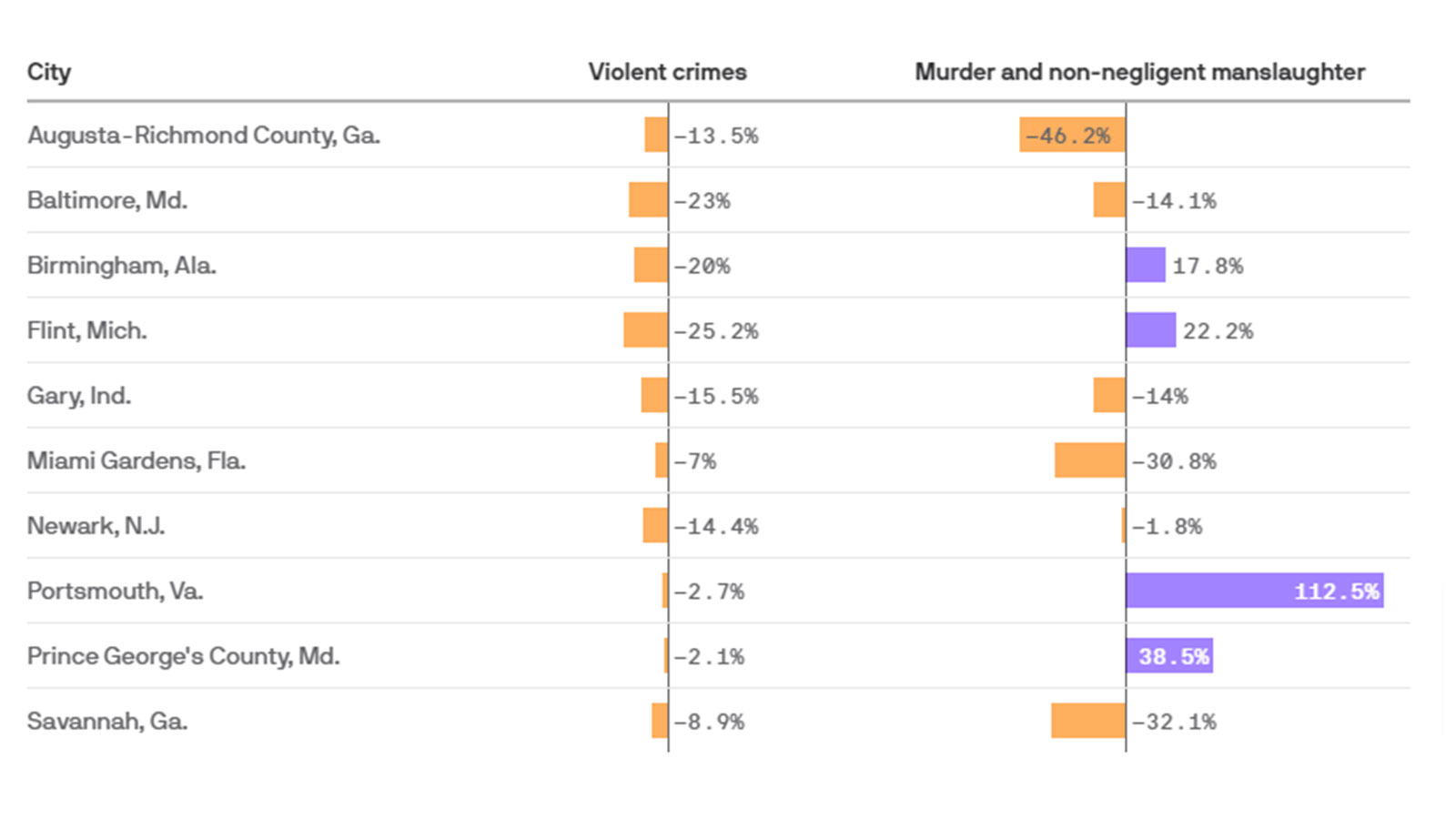Change of overall reported violent crime in majority-Black communities
From cities with populations greater than 25k in 2020; Depicts change between 2019 and 2020

Data: FBI, Alabama Law Enforcement Agency, 2020 Census; Chart: Jacque Schrag/Axios
Despite the national jump, nearly half of America’s medium- and smaller-sized communities with majority Black populations actually saw drops last year in overall reported violent crime, an Axios analysis found.
Why it matters: The trends paint a more nuanced picture about how COVID-19 and racial justice protests actually impacted crime and policing, from Newark, New Jersey, to Baltimore to Gary, Indiana.
Details: Axios reviewed recent FBI crime data, the 2020 census and, where available, state police statistics for 23 majority-Black communities with populations of more than 25,000. The data showed that in 10 of those, overall violent crime actually declined compared with the year before. (In four of those 10, however, the murder rate rose.)
- These communities used a variety of techniques, from revamped training to changes in prosecutions to social spending experiments.
- Police in Newark increased officer training in 2020 and used the Newark Community Street Team, a group made up of former offenders, to defuse unrest during racial justice protests. Newark police also did not fire a shot in 2020.
- Marilyn Mosby, the state’s attorney for Baltimore, stopped prosecuting drug possession, prostitution, trespassing and other minor charges during the pandemic resulting in big crime drops in the city. In March 2021, she made her temporary steps permanent.
- The city of Gary started moving residents out of high-rise public housing complexes and into other affordable housing options. The city this year began a pilot program for 500 residents around guaranteed income.
What they’re saying: “Collaborative efforts during a time of significant racial and social unrest allowed us to keep the city of Augusta free from violent crime,” Mayor Hardie Davis Jr. of Augusta, Georgia, told Axios.
- Violent crime fell in Augusta-Richmond County, Georgia — a Black-majority consolidated city-county next to the Savannah River — after officials imposed a strict pandemic shutdown, unlike the rest of the state.
- Davis said local law enforcement officials also were engaged to perform wellness checks on members of the community.
Between the lines: Some of these cities’ experiences run counter to narratives Republicans are testing for 2022 connecting “defund the police” campaigns with violent crime rates.
- Donald Trump used racist language to describe crime and poverty in Black-majority cities and blamed “defund the police” calls for jumps in crime during his last months in office.
By the numbers: The 10 communities saw an aggregate 17.9% decline in the total number of reported violent crimes from 2019.
- Flint, Michigan, a community of 95,000 people coming out of a water crisis, saw its number of violent crimes decline by more than 25%.
- Birmingham, Alabama, a city of 209,000 that played a key role in the civil rights movement, saw a 20% reduction in violent crime.
- Gary, Indiana, a city outside of Chicago and with a reputation for high crime, witnessed a 15% fall in overall violent crime.
The big picture: The estimated number of violent crimes across the United States rose for the first time in four years in 2020, according to statistics released by the FBI in September.
- The estimated rate of violent crime — such as murder, rape, robbery and aggravated assault — was 387.8 offenses per 100,000 inhabitants, a 5.6% increase from 2019’s rate.
- Of the 23 majority-Black communities whose data we examined, 12, including Detroit and Memphis, Tennessee, saw increases in violent crimes. Data for a 13th city was incomplete.
Between the lines: The decreases are an important nuance, said Amara Enyia, policy and research coordinator for the Movement for Black Lives, because when crime rates rise it often is used as a justification for over-policing that fuels systemic racism in Black and Latino communities.
- “Decreasing crime in some Black communities pushes back against this false narrative that’s been created, that somehow these racial justice uprisings cause violent crime, or somehow the defund movement has led to increases in crime,” Enyia said.
Yes, but: Some of the 10 communities experienced record jumps in murder rates even as their overall violent crime rates declined.
- Birmingham had 106 murders in 2020 — the most in the city in 25 years.
- Murders in Portsmouth, Virginia, a city of 94,000, more than doubled from the year before.
- And eight of the 10 communities still had violent crime rates well above the national average; the exceptions were Augusta-Richmond County, Georgia, and Prince George’s County, Maryland.
Be smart: Ronnie Dunn, an associate professor of urban studies at Cleveland State University, it’s important not to make too many conclusions about trends using only two years’ worth of data.
- “You have to contextualize the regional economy and the age and demographics of the population, particularly the age group that is more likely to be engaged in criminal activity.”
Go deeper: U.S. border cities again see low violent crime rates
Source: Axios
Featured Image: Crime scene “Do not cross” tape. Source: By Tex Texin Wikimedia Commons














